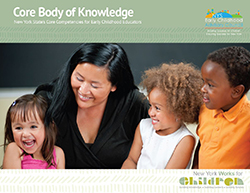
Core Body of Knowledge
New York State's Core Competencies for Early Childhood Educators

5.4
Resources for Competency 5.4:
click to view resource list
Takes Appropriate Health Precautions
The professional working with young children takes precautions that protect children's health and maintains a healthy learning environment
Resources & Media for Understanding Competency 5.4
Behaviors & Skills
-
aProvides information to families verbally and in writing about any unusual level or type of communicable disease to which their child was exposed
-
bIf children have allergies or other health needs, maintains the environment according to the recommendations of the child's health practitioner, knows how the allergy manifests, and what to do in case of exposure
-
cAssures the appropriate implementation of medical and physical care plans
-
dOpens windows or uses other forms of ventilation and sanitizing to eliminate odors, rather than sprays or air fresheners
-
eRegularly washes and sanitizes children's toys, and whenever they have come in contact with bodily fluids
-
fEspecially in infant and toddler spaces, ensures that the floor surfaces used for play are clean, and uses footwear specifically for indoor use at the program
-
gUses fresh water, suitable for drinking, to fill water tables
-
hEnsures that water is drained completely and replaced with fresh water for each new group of children, or that the water table allows for continuous flow and drainage of water
-
iTeaches children proper hand washing procedures upon entering the classroom or program and makes sure children wash their hands before and after eating or handling food, after handling pets and other animals, after using the toilet, and after water and outdoor play
-
jMakes sure that children are dressed appropriately for the weather. Clothes are dry and layered for warmth when necessary.
-
kMakes sure classroom pets or other visiting animals are in good health
-
lInstructs children on safe, proper handling of pets/visiting animals and supervises children's interactions with them
-
mDoes not come to work when they cannot fully participate in the program or if they have a disease that poses a risk to others in the setting
